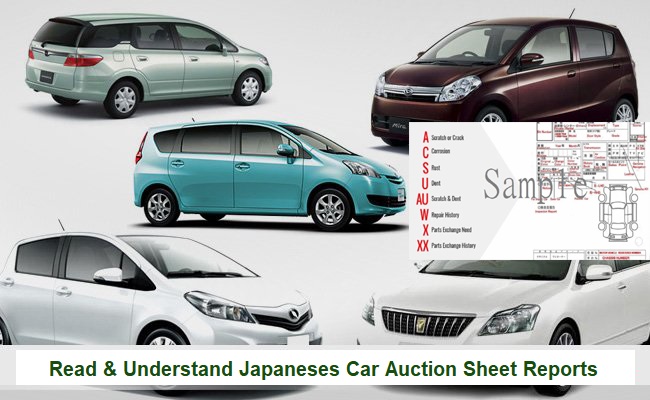Read & Understand Japaneses Car Auction Sheet Reports

Read & Understand Japaneses Car Auction Sheet Reports
If you are planning to buy a Japanese second-hand car, one crucial step you should never skip is verifying the auction sheet. This report serves as the most reliable source of information about the car's history and condition. Buying a used car without checking this report opens up the possibility of being deceived, especially with common fraud tactics such as tampered mileage or hidden repairs.
Japanese car auctions offer a wide range of affordable vehicles, including those with prior damages that are repaired and resold at premium prices. Both new and used vehicles are frequently sold through auction platforms in Japan. These auctions provide the convenience of online purchases while offering transparency through an auction sheet report, detailing the car’s original state before the auction.
What Does an Auction Sheet Contain?
An auction sheet is essentially a thorough vehicle inspection report. It contains detailed information about the car’s mileage, body condition, any prior repairs, and overall performance. Before a car is placed in an auction, it undergoes a comprehensive evaluation to ensure that the buyer gets an accurate idea of its state. Vehicles that are in excellent shape naturally command higher prices, while those with issues are listed at lower rates. No vehicle can be sold at auction before this inspection is complete, and based on the findings, the car is assigned a specific grade.
How Are Auction Grades Determined?
The auction grading system provides a quick snapshot of a vehicle's overall condition. Buyers rely heavily on these grades to make informed decisions about the car’s value. Here's a breakdown of the various grades:
- Grade S: Brand New
- Grade R: Repaired Vehicles
- Grade RA: Accident-Repaired Vehicles
- Grade 6: As Good as New, Minimal Use
- Grade 5: Excellent Condition, Almost New
- Grade 4.5: Very Low Mileage
- Grade 4: Slightly Used, Minor Wear
- Grade 3.5: Average Condition, Some Wear and Tear
- Grade 3: Moderate Damage, Low Price
- Grade 2: Severe Condition
- Accident Cars: ★★★ (Severely Damaged, Needs Significant Repair)
These grades reflect the car’s current condition, offering potential buyers a clear understanding of what they’re getting.

Decoding Auction Sheets for Japanese Cars
Reading an auction sheet may seem tricky at first due to the technical jargon and Japanese language, but it’s fairly straightforward once you understand the key symbols and terms used to describe a vehicle's state:
- Cracks: Y1, Y2, Y3 (small, medium, large)
- Paint Damage: P1, P2, P3 (minor, moderate, significant)
- Windscreen Issues: X1 (tiny crack, ~1cm), R (repaired crack), RX (repaired but needs replacement), X (cracked, must replace)
- Corrosion: C1, C2, C3 (slight, moderate, heavy)
- Replacement Needed: X (part needs replacing), XX (part already replaced)
- Dents: U1, U2, U3 (small, medium, large)
- Distortion: B1, B2, B3 (minor, moderate, major)
- Repair Marks: W1, W2, W3 (light, moderate, extensive repair)
- Rust: S1, S2, S3 (slight, moderate, severe rusting)
- Scratches: A1, A2, A3 (small, medium, large scratches)
- Dimples: E1, E2, E3 (minor, moderate, major)
By understanding the information found on the auction sheet report, you can make an educated decision about the condition and value of a Japanese used car. This ensures that you avoid common scams like hidden repairs or mileage tampering. For added peace of mind, you can also seek an auction sheet translation online to fully grasp the details before making a purchase.
Japanese car auction
auction sheet translation
used car buying guide
vehicle inspection report
Japanese secondhand car
car auction grading
auction sheet report
how to read auction sheets
buying Japanese used cars
Japanese cars in Pakistan
imported Japanese cars
Japanese car prices in 2024
Related Auto News Updates
Latest Discussions
Comments












Add a Comment "Read & Understand Japaneses Car Auction Sheet Reports"